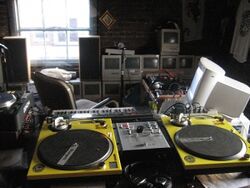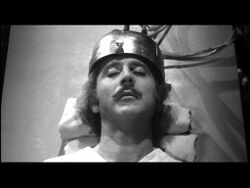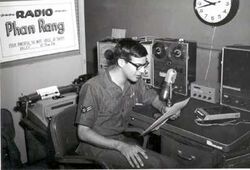Audiophile

An audiophile is not someone who is sexually attracted to sound. Technically, even a "moaner" is not an audiophile. Rather, an audiophile is someone who accumulates a room full of audio equipment.
The ostensible purpose of being an audiophile is to get the best sound possible. This happens in one of two places:
- In the audiophile's tiny apartment next to the train tracks where the neighbors call the police if the volume is above 2, or
- In the audiophile's tiny Hyundai shifted into 4th gear so he can hear the music over the sound of grinding aluminum.
History
Audiophilia began in the 1970s, when many baby boomers were incredibly rich and bored. They had decided that their parents' perfectly acceptable console stereos did not satisfy their inexplicable need to have true, high-fidelity sound.
American capitalism instantly moved to meet this need. Stereo shops sprang up everywhere to sell component stereos. These products were better than console stereos for the following reasons:
- They comprised ten or fifteen different boxes that required their own bookshelf (with no books) instead of a single primitive box that did everything;
- Each of the components had an exotic brand name that sounded either German or Japanese; and
- The total cost was ten times as high.
The increased cost put the new hobby out of the reach of the untrained ear of the common person, while the ability to pick components from different manufacturers suited the audiophile's desire to prove that he was not a mere sucker for an attractive sales pitch, but rather, for many.
Benefits
The stated benefit of audiophilia is building an audio system that will precisely reproduce sound. The actual benefit, of course, is snobbery. The audiophile claims to be the only person in the room who can distinguish the "deep, robust" sound of his four-figure component stereo system from the boom box balanced on DeShawn's shoulder.
In fact, the typical audiophile spent his entire teenage years at loud rock concerts that rendered him completely tone-deaf. He can barely tell that either his own component stereo system or the boom box is switched on at all.
Astonishingly, in the very next decade (the 1980s), the entire face of popular music changed. Suddenly, being able to hear a song with high fidelity was no longer a good thing.
Components
The primary requirement for audiophile gear is the ability to consume a lot of money. This is achieved by dividing the gear into components. Each component is outrageously overpriced. However, the number of components is unlimited.
Source
Every audiophile system needs something that produces the audio. In the pre-audiophile days, an empty Coke bottle or a cowbell would do, but the audiophile demands products that reproduce sound perfectly.
In practice, the audiophile owns several source media, all of which reproduce sound imperfectly, for the sake of being able to play older music. A typical audiophile has one each of all of the following:
- A record player, which plays vinyl records and adds artifacts to the music so that it sounds really old. These artifacts, called "snap, crackle, and pop," led to the invention of breakfast cereal, an important product that gave the audiophile something to eat while enjoying his music.
- Dictaphone belongs here in the list — It is as though you could cut your own record on a plastic belt — but oddly, most audiophiles do not have a dictaphone player in their component system.
- A reel-to-reel tape player. Reel-to-reel tape is so bulky that it must be good. The tape player has "fast forward" and "reverse" (which is fast by definition) so that you can skip to a different song in a matter of minutes, except that you cannot locate it on the reel. Reel-to-reel was the first medium that let the audiophile edit music. (Breaking vinyl discs and trying to glue the right parts back together often failed to produce good results.) To edit a song, the audiophile needs only a razor blade and some Scotch tape.
- An 8-track tape player, because the audiophile has a lot of 8-track cartridges. This medium first raised the possibility of taking music from the home to the car (and back again) and having it sound equally awful in both places.
- A cassette tape player. This supposedly obsoleted the 8-track, but a true audiophile has players for both formats in the component rack. Either type of tape avoids the pops and scratches of vinyl, and replaces them with a constant hiss, which the true audiophile claims does not interfere with the perfect reproduction of the music.
- A compact disc player. Just when audiophiles thought it would not get any better, a new medium was invented. When you loan these discs out and your druggie friend returns them with gouges and scratches, there are no pops and crackles. The disc player smoothly skips over entire verses of the music.
Again, the number of source media is unlimited. The owner of a compact disc player will also need a player for Blu-Ray® discs, Rainbow Coalition® discs, and whatever comes next. The proper audiophile needs at least one player for every conceivable medium. Why? Just ask him.
The audiophile is always tempted by the option of purchasing his entire music collection on the newest, most perfect, recording medium. He could then have a humongo yard sale for the vinyl and tapes, followed by a brief run to the town dump. However, that would mean he was a commercial slave to the large recording labels such as Sony and their evil desire to make every audiophile pay several times for the same thing. The audiophile prefers to be a commercial slave to more benign companies, such as Nakamichi and Marantz, whose brand names were purchased by Sony years ago.
Signal processors
If the audiophile has money left over, he can buy signal processors that either overcome the faults of the media, in order to hear the music the way the artist recorded it — or converters that reproduce the music in a way that would have made the artist leave the business.
In the first group are:
- Dolby processors. They shift the music upward so that only the neighbor's dog can hear it. (Many audiophiles obtain maximum amusement by stopping at this stage.) Then they remove the hiss and shift the music back downward. The result is the experience you would get if you were at a concert and you had a toilet seat upside-down on your head. However, there is no hiss.
- Pre-amplifiers, post-amplifiers, and power amplifiers. These do nothing but make the music very loud. See above, under spending one's teenage years at rock concerts.
The second group is relatively unlimited, as there is only a limited number of ways to overcome the faults of the source medium, but there is an unlimited number of ways to insert new faults of your own. These include:
- Pitch benders, by which the audiophile amuses himself by making Cat Stevens a soprano and Jon Anderson a bass.
- Time benders. These can slow down music without slowing down individual waves (which would make them pitch benders as well). Making a popular song last for 30 minutes (except for MacArthur Park, which already does), is perfect for the audiophile on quaaludes. Having it be over in ninety seconds is a transformation the audiophile performs on his spouse's favorite songs, for which the spouse pays back the audiophile in bed.
- Echo/reverb boxes. These reproduce the awful production values of rock music of the 1960s. Although the audiophile claims to be in avid pursuit of perfect music, this requires that he have an echo/reverb box — to render perfect music imperfect — and then not use it.
Wires
It goes without saying that the components of the audiophile's component stereo system have to be connected to one another. Simple arithmetic reveals that, with n components, any of which can be connected to any other, the number of connectors needed is exactly the amount of money left in the audiophile's pocket.
Each connector can have, on each end:
- An RCA connector
- A 3½ mm mini-stereo connector
- A 2½ mm mini-mini-stereo connector that looks just like the 3½ but doesn't fit
- A 3½ or 2½ that looks like a mini-stereo but doesn't have stereo, which you don't realize until producing a custom version of a song and wondering where the left channel went.
And each of these can be either male or female, except that the oldest (RCA) is bisexual/transgender, which means you have to have one of them or you'll get sued. The audiophile has a desk drawer full of gender-changers and adapters. The audiophile has not used most of these in ten years. For example, RCA connectors no longer connect to the Radio Corporation of America. However, only a few have loose connections inside that will add noise to the music that it will be impossible to trace.
The desk drawer also has the following connectors, which are classified as memorabilia:
- A "standard" stereo connector. The only use for this is to plug your bass guitar directly into the stereo receiver and see how many notes it takes to blow out the power transistors.
- A "balanced" microphone cable. This cable is designed to minimize hum, and would do so, except that the only way to connect it to the stereo is through one of the other adapters in the drawer. Future generations of audiophiles decided to minimize size rather than hum. Modern audiophiles again want to minimize hum, but the size of the junk in the drawer prevents it.
The modern audiophile has also acquired Optical Illusion cables, HDMI cables, and USB cables. These recent inventions have the advantage that they cannot be connected to the older jacks with any gender-changer or adapter in the desk drawer.
An audiophile who has one of each of the above is still not done buying, because damned if he doesn't still hear hum in the background of that six-minute-long drum solo. He needs to buy gold-plated cables. Maybe platinum would work better. Then shielded ones. Then chuck everything out and go entirely digital.
Speakers
Lastly, the audiophile needs speakers. It would seem that headphones (pictured) would be an equivalent alternative, but the true audiophile does not live to hear perfect music but to let his guest know that he lives to hear perfect music, which means that the guest must hear it too.
Mere mortals need only one speaker to hear any one song. Audiophiles should be able to do with two speakers, as you will never meet an audiophile with more than two ears. Nevertheless, true audiophiles buy 2.1 systems, 5.1 systems, and home theater speakers. Unlike real theaters, home theaters never have nearby patrons chewing popcorn loudly or shouting into their cell phones. Nor do home theaters have ushers with flashlights sneaking up to interrupt a good game of pocket pool.
Form factors
The preceding section lists the essential components of the audiophile's component stereo system. However, given that the audiophile is, at base, a snob, it matters less what is in it than how it looks.
Hardwood cabinets
The stereo components and, by all means, the loudspeakers must be in solid hardwood. This does nothing to enhance the sound but everything to enhance the audiophile. Veneer will not do, as that is so superficial. And Formica®? Heavens, that is plastic! It must be oak.
Given that the audiophile has to throw parties, and that most of his friends are beatniks who are stuck in the 1960s, this means that all those oak cabinets have rings from beer bottles and spilled coffee cups, and most have burn marks where cigarettes were left on the edge.
19-inch racks
The 19-inch rack is not indeed an attribute of the audiophile's wife but of his component stereo system. Even if the audiophile buys the new bookshelf for his stereo gear at a trendy, foreign-sounding place like IKEA, after a while the components start to look like simple boxes on a bookshelf. For the untidy audiophile, actual books may horn in on the delicate electronics.
The solution is to buy a 19-inch rack, discard all the stereo components, and buy new stereo components where the sides of the front panel screw into the sides of the rack.
Rack-mounted components must look as though they belong in the system, although they do not, as the audiophile takes pride in picking-and-choosing from different vendors, which proves he is a discerning buyer.
The only way to do this is to have each component come in black. Anodized black aluminum is the only color that everyone does the same way.
Investments in audiophilia
Audiophiles describe their hobby as investing vast sums of money into the purchase of audio gear. This is a curious investment, as the technological advances just discussed guarantee that the value of each investment ultimately goes to zero. Then again, in 2009, Barack Obama described his own spending of vast sums of money as a "reinvestment," proving the wonderful adaptability of words, once freed from the need to mean anything.
Audiophiles who are more serious about investment sometimes hold off buying radios in order to buy Radio Shack. This common stock offered peaks and valleys that reverberated in the audiophile's portfolio, before it too arrived at zero.
Modern problems
Media became near enough to perfection that audiophiles stopped griping about the clicking, flutter, and hiss and started making outrageous claims that they had "golden ears" and could still hear imperfections. However, as entertaining as this was, businessmen know that, once everyone has one of your products, you will go bankrupt unless you do something different and make everyone convert to it. Consequently, once media ceased to be the problem, businessmen decided that media would disappear. All music would become computer files.
Before media disappeared entirely, they became so small that they could no longer have a label or handwriting indicating what music was on them. This was the first of a Next Generation of new problems.
Like everything else in computers, competing companies raced to market despite severe limitations, such as on memory space. Therefore, the first solid-state component music systems had a brand-new set of problems, such as the following:
- Only enough space for ten songs, whose names were required to be 0 through 9.
- A rule that no song could run longer than three minutes. (This used to be a Los Angeles city ordinance, but by the time of digital music, songs had become much longer, and in fact the genre of progressive rock arose with no other purpose.)
- A rush to invent "lossy" encoding systems that would squeeze music into smaller and smaller computer files, losing only sounds that some Ph.D. thinks most pop-pickers would never miss.
All these problems would eventually be solved (though Star Trek tells us that they will reappear at the start of the 23rd Century). However, audiophiles had already bought the newest computerized components and had developed the usual irrational attraction to them. The good audiophile brags how many songs he has managed to fit onto a 2 gigabyte SD card, heedless to the 64 gigabyte chip on his keychain he uses to get into the office at work, and downplays the loss of fidelity. The audiophile can show guests his huge collection of MP3 files. The guest sees only a Windows file folder, which could just as easily be a collection of pornography, as the guest does not actually want to hear the music. The MP3 format deftly solves the problem of limited file space (which has not been a problem at all for a decade).
When audiophiles fight
When several audiophiles get together, however, they can have arguments just like old times. Rather than debate the crackle of vinyl versus the hiss of tape, they can debate whether lossy computer files have lost too much. And — just like the old days — rather than listen to both versions and discuss their perceptions, audiophiles prefer to piss and moan about the great unwashed who demand lower and lower fidelity. They are so convinced that the ordinary man needs to be brought up that it is surprising the audiophiles do not have a political party.
Another popular way for an audiophile to pick a fight with another audiophile is to claim that the old ways were actually better. An audiophile often claims that:
- Stereos based on vacuum tubes had a deeper sound that was pleasant enough to justify a sweltering living room in summer, running to Radio Shack for replacement parts every year, and the occasional apartment fire.
- Dolby solved the hiss problem and there was no need to invent the Compact Disc.
- Digitizing music from vinyl makes it flat and uninteresting.
- "Artifacts" added during the compression to MP3 make for a fascinating listen.
This is very much like touting the benefits of the lovingly restored Indian motorcycle in the garage — which the owner would never actually drive anywhere.
See also
| Featured version: 11 June 2015 | |
| This article has been featured on the main page. — You can vote for or nominate your favourite articles at Uncyclopedia:VFH. | |




